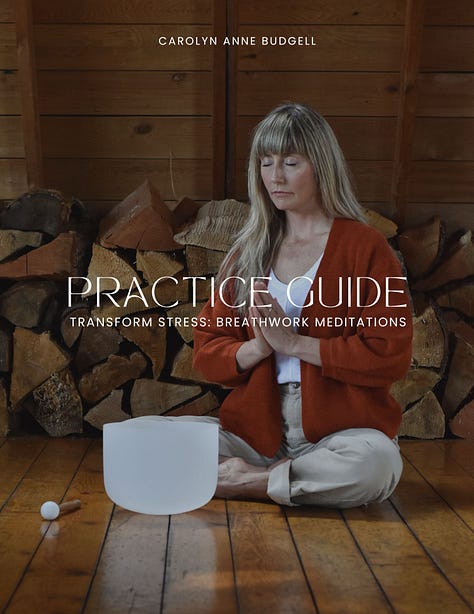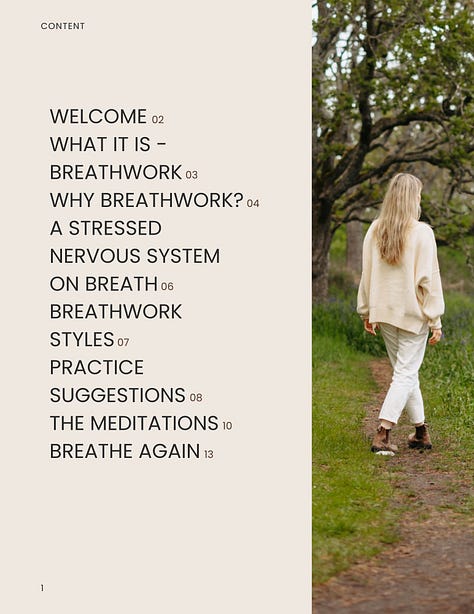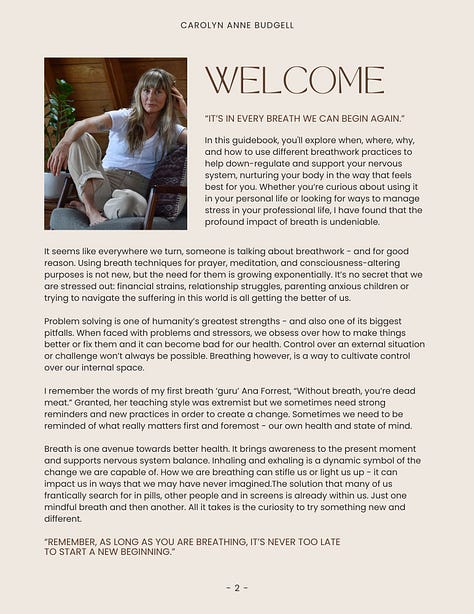Why Breathwork is so good
a free soothing breath + body scan practice and nerdy dissection of breathwork styles
Why Breathwork?
Breath is a profound tool to keep us present and grounded. When busy thoughts and anxiety cloud the mind, we lose connection to our breath. Breathing in a stressed state can lead to poor breath patterns, which then increases anxious thoughts. Turning down the volume on the overthinking mind is possible with controlled breathing.
Deep, slow breathing directly impacts nervous system functioning by regulating the heart rate and triggering the relaxation response. Similarly, mindful breathing affects our state of mind. Recent studies have shown that purposeful breathing can influence brain activity through the vagus nerve, which runs from the brain to the lower abdomen. This nerve transmits the brain’s messages, reinforcing the effects of our breathing patterns. Science also shows that the signals sent from the body to the brain via the vagus nerve are incredibly powerful making deep rhythmic breathing more beneficial than telling yourself to be calm and present. Master teacher BKS Iyengar wasn’t wrong when he said “Breath is king of the mind.” Breath is medicine and helps widen our perspective and transform our minds.
Breath and Stress
The short of it is, controlled Breathing counters the Sympathetic Nervous System’s “fight / flight / freeze” response to daily stresses so that we can navigate stressors with more awareness. Manipulating breath brings an aroused system back to balance. Just two minutes of Breathwork has been shown to be highly effective and immediate in situations of high stress.
Benefits of Breathwork
Manages Stress: Our brains are routinely on high alert for threats in our environment - we’re wired to react defensively to anything that hints of imperiling us physically or psychologically. Controlled breathing is a potent tool for preventing our brains from keeping us in a state of stress. It prevents subsequent damage caused by high stress levels. The relaxation response attained from breath is a built-in way to keep stress in check.
Manages Anxiety: Controlled breathing triggers the parasympathetic nervous system by stimulating the vagus nerve—which mediates nervous system responses and lowers heart rate.
Sparks Brain Growth: When controlled breathing is used to facilitate meditation, the result can be an actual increase in brain size. Specifically, the brain experiences growth in areas associated with attention and processing of sensory input.
Changes Gene Expression: Controlled breathing can alter the expression of genes involved in immune function, energy metabolism and insulin secretion.
Sensed Benefits of Breathwork
Each controlled breath is a chance to direct attention away from our fixation on controlling life. There really is some kind of healing to be felt every time we are aware of breath - no wonder these techniques have been utilized by many cultures for millennia.
Relieves stress and allows the nervous system to become more flexible over time and with patience.
Expands our window of tolerance so we can sit with and work through emotions with more ease (building interoception), compassion and awareness.
Offers the ability to focus on the present moment. We clear the noise and tap into stillness – where we can find clarity.
Reminds us of our true power; the infinite life force energy we hold within us.





Purchase a Calm + Ease or Invigorate + Awaken Meditation Bundle (Guidebook included) here. Start or continue your journey of Breathwork from the comfort of your own home. And for extra support, I’m always just an email away!
Breathwork Styles:
Pranayama, Breathwork or Controlled Breathing are all umbrella terms for the breathingtools that help us achieve various states of energy or change within the body.
Pranayama, Breathwork or Controlled Breathing are all umbrella terms for the breathing tools that help us achieve various states of energy or change within the body.
There are a multitude of directions to take our breath when we sit down for a formal practice. So when using a term like breathwork - it helps to be specific. Is it a practice for regulating a frantic system with cooling, calming or base level techniques such as Brahmari or Interrupted Breath? Or perhaps the breathwork is heating or activated to stir up stagnancy like Kapalabhati or Holotropic?
Let’s review some basic definitions below in order to better understand what you’re embarking upon and how to modify for your current baseline of comfort.
Restful
Breathwork to find calm and ease. When we breathe slowly, lightly and into our belly, our brain activates the rest + digest response so we can recover and recharge. The goal of a calming style of breathwork is to regulate frantic energy. This is an excellent category to visit right before bedtime. Enjoy these practices to down-regulate, down shift, soothe and bring you back to balance. See the practice at the end of this article to rest right now, with me :)
Energizing
Breathwork to invigorate and awaken. When we use techniques such as the Kappalabhati, the Physiological Sigh, Circular Breath and breath holds (retentions), we send signals to the brain to wake up and be alert. An invigorating breathwork is all about clearing out the residue of stress, releasing it rather than trying to soothe it. The feelings of relaxation and ease will come naturally upon completion of an energizing session.
Transformative
In active breathwork like Holotropic, Wim Hof or 2 Stage Pranayama Breathwork Meditation, we utilize fast and full breaths through the mouth to deliberately activate fight or flight to boost clarity and resilience. This is your nervous system getting a ‘supercharge’. They are breathing styles that can lead to a heightened healing through emotional releases and altered state of consciousness. Very brief practices (and ideally in person with an experienced guide) of this breathing style are best for newcomers or anyone with a history of panic attacks or asthma.
A Treat for You …
Relax & Rest Deeply - Meditation
13 minutes of soft clearing breaths and body scanning.




